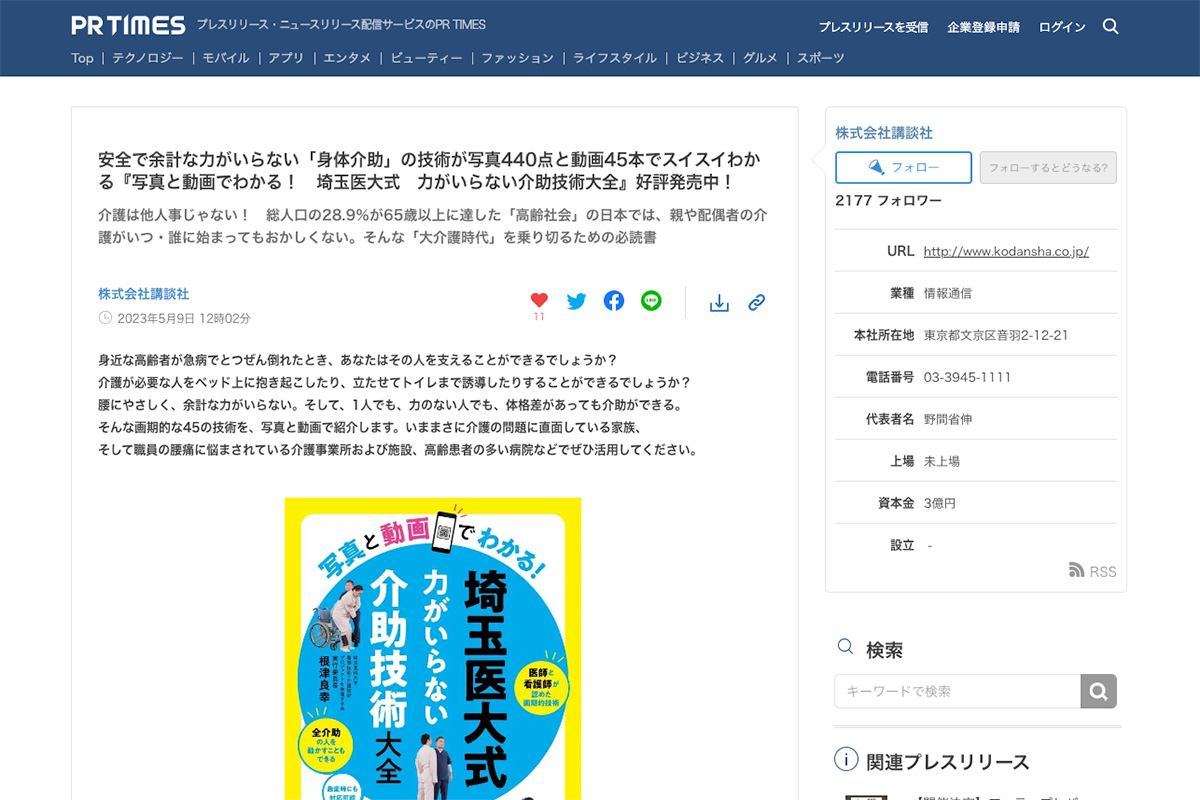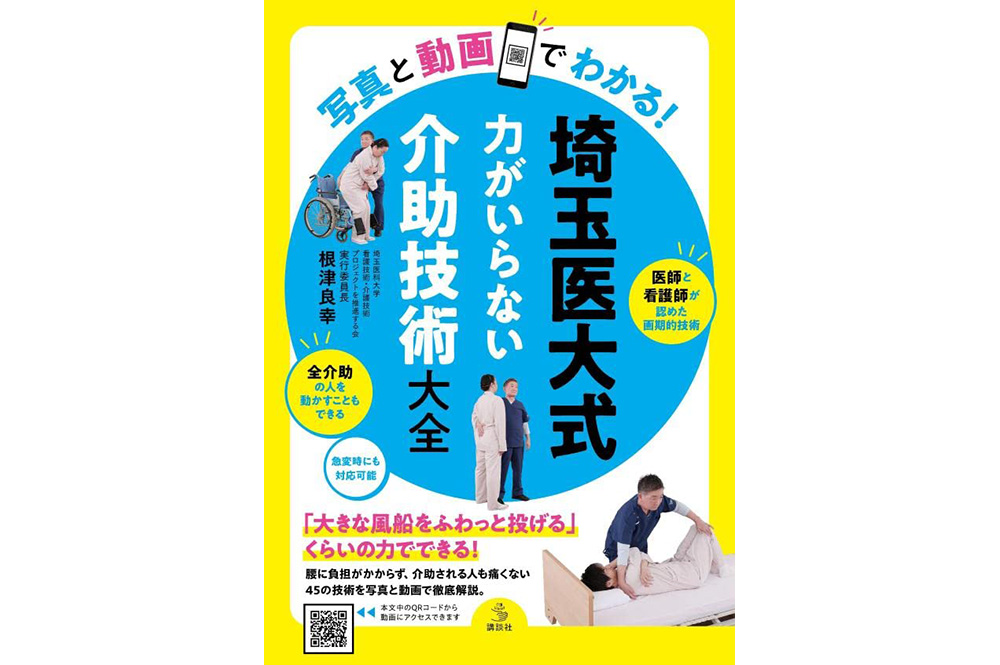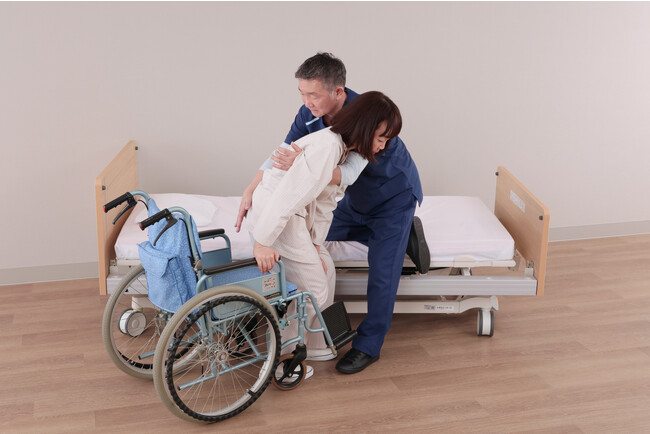A press release of "Saitama Medical University Style: Comprehensive Techniques for Assistance that Require No Force" by Yoshiyuki Nezu was released by Kodansha.

A book that shows safe "physical assistance" techniques that require no extra effort with 440 photos and 45 videos! The book is titled "Saitama Medical University Style: Comprehensive Techniques for Assistance that Require No Force" and is now on sale!
Kodansha Ltd.
Nursing care is not something that is a matter for others! In Japan, an "aging society" where 28.9% of the total population is now 65 years old or older, care for parents or spouses may begin at any time and for anyone. This book is a must-read for surviving such a "Great Nursing Care Era"!
If an elderly person close to you suddenly fell ill, would you be able to support him or her?
Can you pick up someone in need of care in bed or stand them up and lead them to the bathroom?
It is gentle on the lower back and does not require extra strength. And it can be used by one person or by people with limited strength, even if there is a difference in body size.
These 45 groundbreaking techniques are presented here in photos and video. This book is for families facing caregiving problems right now, and for nursing homes, facilities, and hospitals with many elderly patients who are suffering from back pain.

Some video and photo examples are available!
'How to get a patient with a low level of care to sit up in bed.'
'How to support someone from behind when they fall backwards.'

'How to get someone from a wheelchair to a bed.'
Other caregiving techniques for various situations are explained in an easy-to-understand manner with videos and photos!
<Contents>
Chapter 1: What is the Saitama Medical University Style of assistance?
Five points of " Saitama Medical University Style”
Let's know "which way people fall."
Standing, body use, breathing, etc.
Chapter 2: Moving and Waking the Body in Bed
Basic turning assistance
Have the patient sit on the bed - in the case of a patient with a low care level
Maintain sitting posture, etc.
Chapter 3: Standing up from a sitting position
For patients with a low level of care: Hand-guided standing up
For patients with a slight difference in body size: Stand up by putting your hands behind your back.
For patients with weak legs: Stand up by placing the base of the thumb on the patient's back.
Chapter 4: Supporting on the body, moving, and sitting
3 Things You Need to Know to Prevent Caregiver Accidents
Side-by-side position holding
Support from the front - when the standing position is unstable or when the body collapses
Sitting on a bed (chair)
Putting the patient to bed, etc.
Chapter 5: Getting Around in a Wheelchair
Significance and difficulty of wheelchair assistance
Names of each part of the wheelchair and 5 points to check
How to unfold a wheelchair / How to fold a wheelchair
Transferring from bed to wheelchair
Make them sit up deeply, etc.
[Excerpt from "Introduction" by the author, Yoshiyuki Nezu.]
In 2022-23, I had the opportunity to present the caregiving technique described in this book in Monaco, Dubai, and Saudi Arabia.
In Monaco, I demonstrated the caregiving movements of a man over two meters tall, who was at least two heads taller than I was, using him as a model for those who needed care. I am sure that those who watched the demonstration were skeptical, wondering, "Can I really move such a big man? However, when I showed them how easily I could raise the model from the bed, they were astonished and said, "It's a miracle! I was able to move such a large man.
Is it because I am a strong man that I was able to move a model that is much bigger than I am? Not at all. When I was 39 years old, I suffered a stroke that left me paralyzed on the left side of my body. Since then, I have suffered from other illnesses and have experienced harsh treatment, including surgery. Although I look, talk, walk, and live normally, the effects of my illnesses and treatments have left me without much in the way of arm strength. For example, I have very little grip strength left in both hands. However, even with such limited strength, it is possible to provide physical assistance if one understands the key points. There is no need to rely on arm strength at all.
This book introduces physical assistance that can be done by people as weak as I am, and that does not require any extra strength. The fact that they do not require much effort also means that they are less likely to cause physical (especially back) pain. While forceful assistance can cause back pain, if the methods described in this book are followed correctly, the burden on the back will be virtually eliminated.
<Product Information>
Book title: "Saitama Medical University Style: Comprehensive Techniques for Assistance that Require No Force.”
Release date: Apr. 27, 2023
Author: Yoshiyuki Nezu
List price: 2,420 yen (tax included)
Code: 978-4-06-531161-5
Type of edition: B5
<Amazon>
https://www.amazon.co.jp/dp/4065311616
Go to Corporate Press Release Details
(2023/05/09 12:02)
- "Saitama Medical University Style: Comprehensive Techniques for Assistance that Require No Force” written by Yoshiyuki Nezu was featured in "Jiji Medical"!
- Yoshiyuki Nezu's book, "Saitama Medical University Style: Comprehensive Techniques for Assistance that Require No Force” was featured in "President Online"!
- "Saitama Medical University Style: Comprehensive Techniques for Assistance that Require No Force” written by Yoshiyuki Nezu was featured in "Oricon News"!
- "Saitama Medical University Style: Comprehensive Techniques for Assistance that Require No Force” written by Yoshiyuki Nezu was featured in "The Yomiuri Shimbun Online"!



